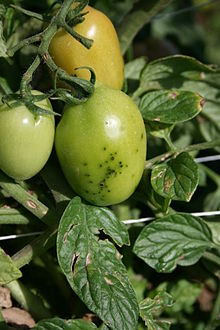| Pseudomonas syringae | |
|---|---|

| |
| Cultures of Pseudomonas syringae | |
| Scientific classification | |
| Domain: | Bacteria |
| Phylum: | Pseudomonadota |
| Class: | Gammaproteobacteria |
| Order: | Pseudomonadales |
| Family: | Pseudomonadaceae |
| Genus: | Pseudomonas |
| Species: | P. syringae
|
| Binomial name | |
| Pseudomonas syringae Van Hall, 1904
| |
| Type strain | |
| ATCC 19310 CCUG 14279 | |
| Pathovars | |
|
P. s. pv. aceris | |
Pseudomonas syringae is a rod-shaped, Gram-negative bacterium with polar flagella. As a plant pathogen, it can infect a wide range of species, and exists as over 50 different pathovars,[2] all of which are available to researchers from international culture collections such as the NCPPB, ICMP, and others.
Pseudomonas syringae is a member of the genus Pseudomonas, and based on 16S rRNA analysis, it has been placed in the P. syringae group.[3] It is named after the lilac tree (Syringa vulgaris), from which it was first isolated.[4]
A phylogenomic analysis of 494 complete genomes from the entire Pseudomonas genus showed that P. syringae does not form a monophyletic species in the strict sense, but a wider evolutionary group that also included other species as well, such as P. avellanae, P. savastanoi, P. amygdali, and P. cerasi.[5]
Pseudomonas syringae tests negative for arginine dihydrolase and oxidase activity, and forms the polymer levan on sucrose nutrient agar. Many, but not all, strains secrete the lipodepsinonapeptide plant toxin syringomycin,[6] and it owes its yellow fluorescent appearance when cultured in vitro on King's B medium to production of the siderophore pyoverdin.[7]
Pseudomonas syringae also produces ice nucleation active (INA) proteins which cause water (in plants) to freeze at fairly high temperatures (−1.8 to −3.8 °C (28.8 to 25.2 °F)), resulting in injury.[8] Since the 1970s, P. syringae has been implicated as an atmospheric biological ice nucleator, with airborne bacteria serving as cloud condensation nuclei. Recent evidence has suggested the species plays a larger role than previously thought in producing rain and snow. They have also been found in the cores of hailstones, aiding in bioprecipitation.[9] These INA proteins are also used in making artificial snow.[10]
Pseudomonas syringae pathogenesis is dependent on effector proteins secreted into the plant cell by the bacterial type III secretion system. Nearly 60 different type III effector families encoded by hop genes have been identified in P. syringae.[11] Type III effectors contribute to pathogenesis chiefly through their role in suppressing plant defense. Owing to early availability of the genome sequence for three P. syringae strains and the ability of selected strains to cause disease on well-characterized host plants, including Arabidopsis thaliana, Nicotiana benthamiana, and the tomato, P. syringae has come to represent an important model system for experimental characterization of the molecular dynamics of plant-pathogen interactions.[12]


- ^ "Pseudomonas syringae pv. persicae (PSDMPE)[Overview]". Global Database. EPPO (European and Mediterranean Plant Protection Organization). 28 January 2001. Retrieved 22 March 2022.
- ^ Arnold, DL; Preston, GM (2019). "Pseudomonas syringae: enterprising epiphyte and stealthy parasite". Microbiology. 165 (3): 251–53. doi:10.1099/mic.0.000715. PMID 30427303.
- ^ Anzai, Y; Kim, H; Park, JY; Wakabayashi, H; Oyaizu, H (2000). "Phylogenetic affiliation of the pseudomonads based on 16S rRNA sequence". International Journal of Systematic and Evolutionary Microbiology. 50 (4): 1563–89. doi:10.1099/00207713-50-4-1563. PMID 10939664.
- ^ Kreig, N. R.; Holt, J. G., eds. (1984). Bergey's Manual of Systematic Biology. Baltimore: Williams and Wilkins. pp. 141–99.
- ^ Nikolaidis, Marios; Mossialos, Dimitris; Oliver, Stephen G.; Amoutzias, Grigorios D. (August 2020). "Comparative Analysis of the Core Proteomes among the Pseudomonas Major Evolutionary Groups Reveals Species-Specific Adaptations for Pseudomonas aeruginosa and Pseudomonas chlororaphis". Diversity. 12 (8): 289. doi:10.3390/d12080289.
- ^ Scholz-Schroeder, Brenda K.; Soule, Jonathan D.; Gross, Dennis C. (2003). "The sypA, sypB, and sypC Synthetase Genes Encode Twenty-Two Modules Involved in the Nonribosomal Peptide Synthesis of Syringopeptin by Pseudomonas syringae pv. syringae B301D". Molecular Plant-Microbe Interactions. 16 (4): 271–80. doi:10.1094/MPMI.2003.16.4.271. PMID 12744455.
- ^ Cody, YS; Gross, DC (1987). "Characterization of Pyoverdin(pss), the Fluorescent Siderophore Produced by Pseudomonas syringae pv. syringae". Applied and Environmental Microbiology. 53 (5): 928–34. Bibcode:1987ApEnM..53..928C. doi:10.1128/AEM.53.5.928-934.1987. PMC 203788. PMID 16347352.
- ^ Maki, Leroy (September 1974). "Ice Nucleation Induced by Pseudomonas syringae". Applied Microbiology. 28 (3): 456–59. doi:10.1128/AEM.28.3.456-459.1974. PMC 186742. PMID 4371331.
- ^ Palmer, Jason (25 May 2011). "Bacteria-rich hailstones add to 'bioprecipitation' idea". BBC News.
- ^ Robbins, Jim (24 May 2010). "From Trees and Grass, Bacteria That Cause Snow and Rain". The New York Times.
- ^ "PPI home – Pseudomonas-Plant Interaction – Pseudomonas syringae Genome Resources Home Page". Cornell University & National Science Foundation & USDA ARS. 3 September 2010. Retrieved 22 March 2022.
- ^ Mansfield, John (2012). "Top 10 plant pathogenic bacteria in molecular plant pathology". Molecular Plant Pathology. 13 (6): 614–29. doi:10.1111/j.1364-3703.2012.00804.x. PMC 6638704. PMID 22672649.